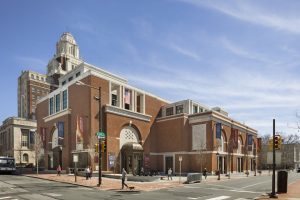THE LAYERS OF THE PAST
 Ian Volner’s review of Robert A. M. Stern’s Museum of the American Revolution in Philadelphia is more even-handed that Inga Saffron’s mean-spirited screed in the Inquirer. But both critics miss an important aspect of Stern’s design: its relation to the nearby U.S. Custom House. That 17-story tower is the most prominent building in the area and provides a backdrop to the museum, evident in Peter Aaron’s evocative photograph. The museum echoes some of the brick and limestone details, as well as the crowning lantern. The Custom House, a WPA project completed in 1934, was the work of Verus T. Ritter and Howell L. Shay (Shay had worked for Horace Trumbauer, and is credited with the parti for the latter’s Philadelphia Museum of Art). The brick and limestone Custom House combined an Art Deco sensibility with Federal details and forms in a masterly way. Thus Stern’s museum, far from being latter-day Georgian revival, as both Volner and Saffron suggest, is really a twenty-first century interpretation of an early twentieth century take on American Federal, which itself was a version of British Georgian. Personally, I find the recessed arches of the museum’s facade to be a little heavy-handed, but the dialogue with the many pasts of Philadelphia is interesting and bears mention. Incidentally, Saffron suggests that there is something unseemly in using Georgian stylistic references in a building commemorating a war fought “to free ourselves from the Georgian tyranny.” But the Founding Fathers were not revolting against British civilization, only British rule; in architecture they were content to take their lead from their British cousins.
Ian Volner’s review of Robert A. M. Stern’s Museum of the American Revolution in Philadelphia is more even-handed that Inga Saffron’s mean-spirited screed in the Inquirer. But both critics miss an important aspect of Stern’s design: its relation to the nearby U.S. Custom House. That 17-story tower is the most prominent building in the area and provides a backdrop to the museum, evident in Peter Aaron’s evocative photograph. The museum echoes some of the brick and limestone details, as well as the crowning lantern. The Custom House, a WPA project completed in 1934, was the work of Verus T. Ritter and Howell L. Shay (Shay had worked for Horace Trumbauer, and is credited with the parti for the latter’s Philadelphia Museum of Art). The brick and limestone Custom House combined an Art Deco sensibility with Federal details and forms in a masterly way. Thus Stern’s museum, far from being latter-day Georgian revival, as both Volner and Saffron suggest, is really a twenty-first century interpretation of an early twentieth century take on American Federal, which itself was a version of British Georgian. Personally, I find the recessed arches of the museum’s facade to be a little heavy-handed, but the dialogue with the many pasts of Philadelphia is interesting and bears mention. Incidentally, Saffron suggests that there is something unseemly in using Georgian stylistic references in a building commemorating a war fought “to free ourselves from the Georgian tyranny.” But the Founding Fathers were not revolting against British civilization, only British rule; in architecture they were content to take their lead from their British cousins.
Witold Rybczynski's Blog
- Witold Rybczynski's profile
- 176 followers



